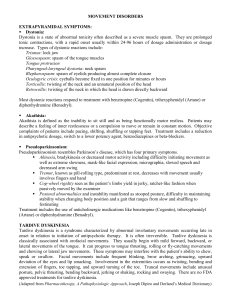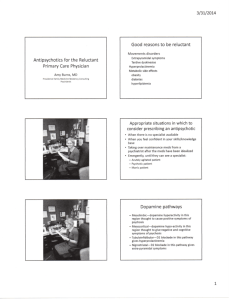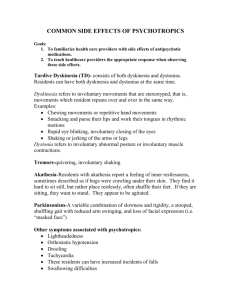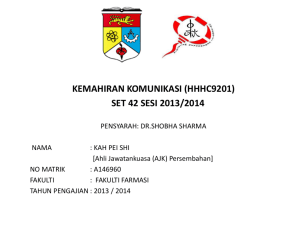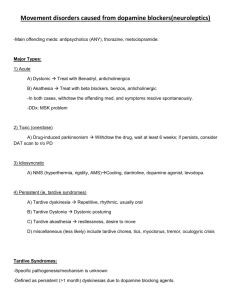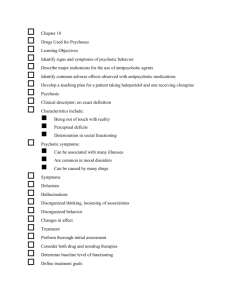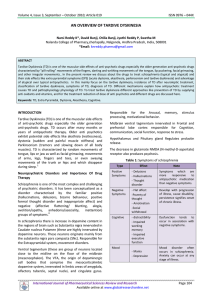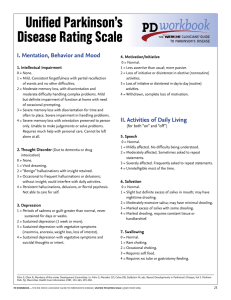Extrapyramidal side effects
advertisement
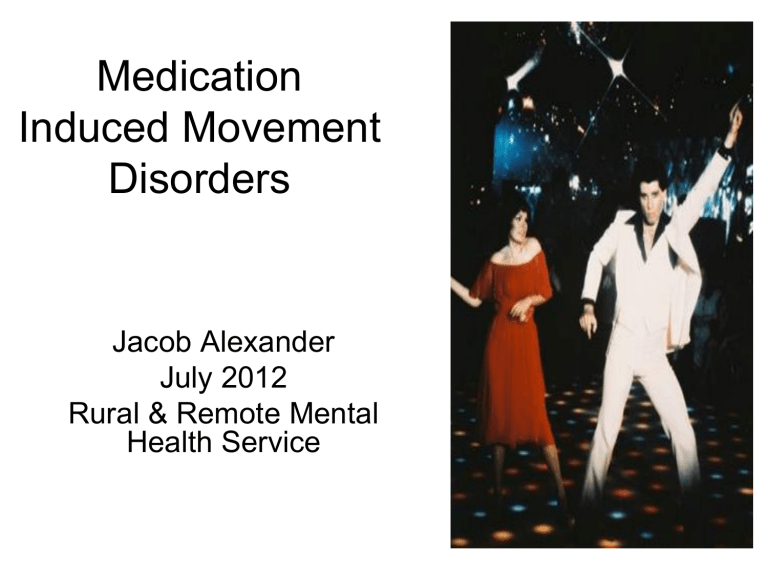
Medication Induced Movement Disorders Jacob Alexander July 2012 Rural & Remote Mental Health Service Extra pyramidal system • • • • • • • • • • Anatomical Neural Network that is part of the motor system Reticular formation of the pons and the medulla Nigrostriatal pathway Basal Ganglia Cerebellum Cerebral cortex- motor and sensory areas Functional Causes involuntary reflexes and movements Locomotion Complex movements Postural control Extrapyramidal Tracts Extrapyramidal Tract Extrapyramidal Side Effects (EPSEs) • The first generation (conventional) antipsychotics may cause significant extrapyramidal side effects, more so than the second generation antipsychotic agents. • Risperidone and Ziprasidone more likely to cause EPSEs amongst second generation antipsychotic agents • EPSEs require careful assessment and management Objectives Objectives • Early Identification • Encourage and alleviate anxiety for patient and carers • Be able to explain causes • Be able to explain treatments • Draw attention of appropriate health personnel to phenomena Types of EPSEs • • • • • Dystonia Parkinsonism Akathisia Tardive Dyskinesia Acetylcholine-Dopamine dysregulation syndromes Dystonia • Occurs usually within 48 hours of initiation of the medication • Involves bizarre and severe muscle contractions • Can be painful and frightening • Characterized by odd posturing and strange facial expressions Drug-induced Parkinsonism • Usually occurs after 3 or more weeks of treatment • Characterized by: – Cogwheeling rigidity – Tremors – Rhythmic oscillations of the extremities – Pill rolling movement of the fingers Akathisia • Usually occurs after 3 or more weeks of treatment • Subjectively experienced as desire or need to move • Described as feeling like jumping out of the skin • Mild: a vague feeling of apprehension or irritability • Severe: an inability to sit still, resulting in rocking, running, or agitated dancing Tardive Dyskinesia Dyskinesia Tardive • Usually occurs late in the course of longterm treatment • Characterized by abnormal involuntary movements (lip smacking, tongue protrusion, foot tapping) • Often irreversible Complications of Tardive Complications of Tardive Dyskinesia Dyskinesia • • • • • Inability to wear dentures Impaired respirations Weight loss Impaired gait Impaired posture Dopamine-Acetylcholine Imbalance in the Extrapyramidal System • A rare side effect • Characterized by hallucinations, dry mouth, blurred vision, decreased absorption of antipsychotics, decreased gastric motility, tachycardia, and urinary retention • Neuroleptic Malignant Syndrome Methods to Improve Assessment of EPSEs • Use rating scales. – AIMS – Simpson Neurological Rating Scale • Videotape the exam for comparison at a later date Treatment Treatment of EPSEs • Titrate dose • Switch to AP less likely to cause extrapyramidal side-effects • Evaluate need for EPSE causing other meds- metaclorpromide, amoxapine, SSRIs • Anticholinergic agents- benztropine, trihexyphenidyl, benadryl • Akathisia- benzodiazepines and beta blockers • • • • http://youtu.be/pSXzuCNlI6Q akathisia http://youtu.be/2krwEbm5hBo dystonia http://youtu.be/_s1lzxHRO4U catatonia http://youtu.be/FUr8ltXh1Pc tardive dyskinesia • http://youtu.be/j86omOwx0Hk parkinsonism
